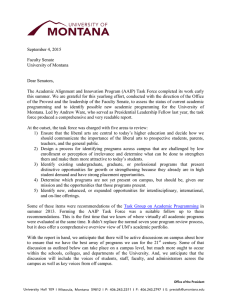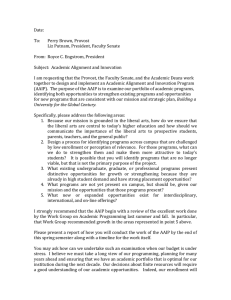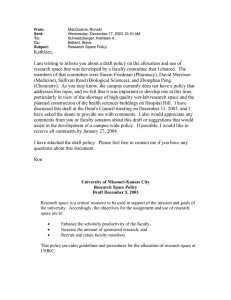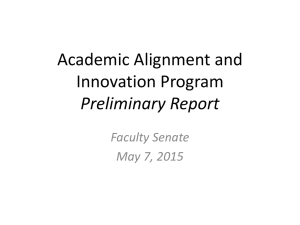Document 11921244
advertisement
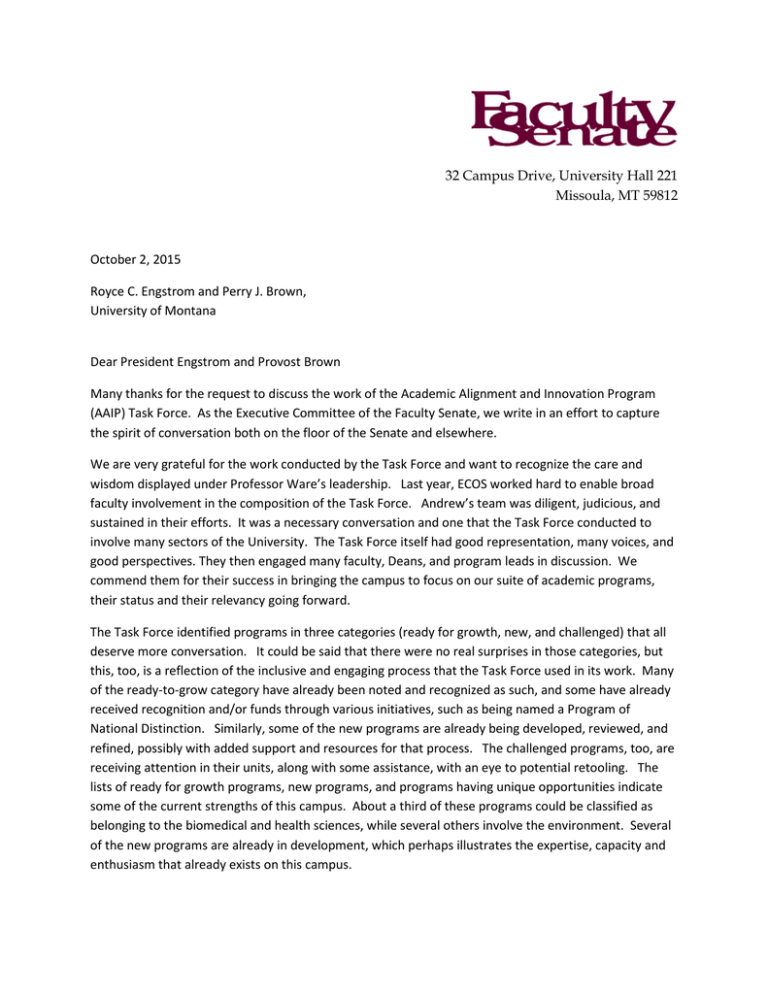
32 Campus Drive, University Hall 221 Missoula, MT 59812 October 2, 2015 Royce C. Engstrom and Perry J. Brown, University of Montana Dear President Engstrom and Provost Brown Many thanks for the request to discuss the work of the Academic Alignment and Innovation Program (AAIP) Task Force. As the Executive Committee of the Faculty Senate, we write in an effort to capture the spirit of conversation both on the floor of the Senate and elsewhere. We are very grateful for the work conducted by the Task Force and want to recognize the care and wisdom displayed under Professor Ware’s leadership. Last year, ECOS worked hard to enable broad faculty involvement in the composition of the Task Force. Andrew’s team was diligent, judicious, and sustained in their efforts. It was a necessary conversation and one that the Task Force conducted to involve many sectors of the University. The Task Force itself had good representation, many voices, and good perspectives. They then engaged many faculty, Deans, and program leads in discussion. We commend them for their success in bringing the campus to focus on our suite of academic programs, their status and their relevancy going forward. The Task Force identified programs in three categories (ready for growth, new, and challenged) that all deserve more conversation. It could be said that there were no real surprises in those categories, but this, too, is a reflection of the inclusive and engaging process that the Task Force used in its work. Many of the ready-to-grow category have already been noted and recognized as such, and some have already received recognition and/or funds through various initiatives, such as being named a Program of National Distinction. Similarly, some of the new programs are already being developed, reviewed, and refined, possibly with added support and resources for that process. The challenged programs, too, are receiving attention in their units, along with some assistance, with an eye to potential retooling. The lists of ready for growth programs, new programs, and programs having unique opportunities indicate some of the current strengths of this campus. About a third of these programs could be classified as belonging to the biomedical and health sciences, while several others involve the environment. Several of the new programs are already in development, which perhaps illustrates the expertise, capacity and enthusiasm that already exists on this campus. Of course, many of the academic programs that fell “in the middle” and didn’t make one of these three categories are successful, important, and worthy of attention, support, and resources. Many of these programs are well known nationally and internationally, produce high-quality graduates of our University, and represent the shared talents of our faculty, students, staff, and administration. We also note that many of the successful academic programs that didn’t make the “ready-for-growth” category not only make important and necessary educational contributions to those “ready-for-growth” programs, but are also key components of the University’s interdisciplinary, international, and online programs. We fully recognize that this is the start of a longer campus conversation. There is a common desire to know more information about what our campus does and should be offering in the way of academic programs. The more we know what we, collectively, are working on and towards, and the more transparent the basis is upon which academic programming developments and decisions are being made, the stronger we feel the University can become. We also recognize that given the data and Task Force-initiated questions, many Deans and program leads are continuing to identify what might be constraining enrollments, and how more investments of time and resources can best be made. It is not clear that an AAIP Implementation group would be much more informed than the original Task Force. There is a definite wariness from some faculty to being involved in such a group, partially because they would likely not want to be seen as agents of reductions or reassigning of resources. (We do note that section 18.500 Retrenchment of the UM Contractual Bargaining Agreement has procedures for a Review Committee to consider documentation that includes, but is not limited to, references to program duplication, quality, and productivity.) But, perhaps more importantly, even well-informed faculty may not feel that they fully understand the full suite of UM’s academic offerings or the “bigger picture” of how the various academic programs fit together. Individual program leads and individual Deans may well have a strong sense of activity, of what is working well, and where the best strategic investments may be made. Still, faculty seek full engagement in these issues. While difficult at the campus-wide level, productive academic conversations can be had at the unit, college and school level. There is still much to be learned and understood without the charge of picking winners and losers. In particular, the recognition of specific industry and societal trends are a strength of faculty, unit, and college leadership. We are in frequent conversation and engagement with our various external partners and cooperators through our teaching, research, and outreach activities. Faculty and unit leaders also have the perspective of long-term patterns and may be somewhat resistant to urgent demands that can turn out to be “passing fancies.” Still, campus-wide conversations surrounding broad strategic questions are very welcome and worthwhile, since they are without the need to delve deeply into the specifics of programs. The campus conversation around liberal arts and sciences education, online classes, and interdisciplinary programs are all very important. Faculty expressed the foundational importance of a broad liberal arts and sciences education to this campus. This is our heritage and our strength. Students, faculty, and employers all value the flexible, critical and informed thinkers that that foundation helps provide. Those students go on to be articulate and persuasive, ready for the challenges of future studies and our society. Our comments here are not limited to those who graduate from traditional programs in the arts and sciences, but also to the many programs that rely upon that broad foundation in the arts and sciences. The skills and commitments to learning, citizenship, and human creativity are equally valued by many of the technical and specialized programs. In particular, we note that the liberal arts and sciences make substantial contributions to the international and inter-disciplinary efforts of our campus. We look forward to the October 26-27 conference, Defining a 21st Century Education for a Vibrant Democracy, as well the continued strategic work of the Internationalization Lab. That effort (iLab) demonstrates the time, effort, and commitment that it takes to advance a distinct academic agenda in the international context and perhaps serves as a model of process that might also be used for online education, interdisciplinary programming, and perhaps even the General Education program itself. Such an effort might also clarify academic oversight of online and inter-disciplinary programming. We have also come to appreciate the interconnectedness of UM’s academic programs. The AAIP Task Force may not have had the opportunity fully to investigate this, particularly with the excellent programby-program review they conducted. However, there are many links and co-dependencies between the various academic programs, and a reductive breakdown by program makes that hard, by definition, to see. We have overlapping curriculum, with many flourishing programs that include courses from, say, challenged programs. We rely upon one another’s courses, and many of our successful programs are interdisciplinary. There is also a link between undergraduate and graduate offerings – TA’s are essential recruiting and resourcing tools for graduate programs, but are clearly tied to the instructional needs of undergraduate programs. Similarly, some graduate programs are inter-twined between teaching and research capacity. For instance, many highly successful research doctoral programs have ‘feeder’ programs at the Masters level. We acknowledge that it is much harder to measure and monitor the inputs and outputs of these interconnected and inter-disciplinary programs. In part, because of this interconnected nature of UM’s academic programs, we do not wish to pit liberal arts and sciences education against the programs of the technical and professional schools. It would be easy to see support of one as a weakening of another. Similarly, we recognize a tension between shortterm funding (perhaps of new initiatives) versus a long-term commitment towards strong, core activities. In considering some of the comments of “challenged” programs, we have heard suggestion that short-term fluctuations don’t accurately indicate the long-term need for a particular program. The limitations of any data collection effort needs to be acknowledged. The data compiled and considered by AAIP didn’t make the decisions, but merely served as an alert for the Task Force to engage the programs, chairs and deans in a conversation. The data provides only a snapshot, perhaps of a peculiar time period. While there will always be a desire for better data, better metrics, and better comparisons with comparative schools (checking in how are we doing, how are we distinctive), we can also sound a note of caution that data about the very diverse programs at UM will always be limited. Any decision about what data are collected (and over which time periods) will always favor some programs over others. Overall, more data (different, not necessarily better) might not make much difference but may become yet another burden for our programs and faculty (at least if data needs to be collected and reported at the program level). We believe AAIP has initiated some very important conversations regarding the portfolio of academic programs that UM will carry into the future, and we look forward to being fully engaged in those conversations. Sincerely, Bill Borrie John Kenneth DeBoer Forestry & Conservation Theatre & Dance Mary-Ann Bowman Social Work Michael S. Mayer History Nikolaus Vonessen Mathematical Sciences James W. Sears Geosciences Larry Howell Law
